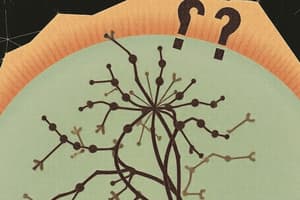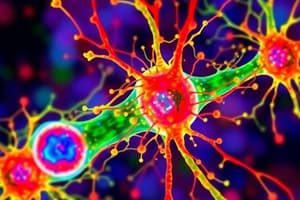Podcast
Questions and Answers
What is the primary role of connexins in cellular communication?
What is the primary role of connexins in cellular communication?
- They interact with cadherin to stabilize cell adhesion.
- They provide structural support to the cell membrane.
- They serve as the major protein component of gap junctions. (correct)
- They help create tight junctions between cells.
What occurs when tight junctions fail to function properly?
What occurs when tight junctions fail to function properly?
- Catenin levels increase significantly.
- Materials can pass freely between cells. (correct)
- Substances are prevented from leaking across the free surface.
- There is increased electrical coupling between cardiac cells.
What major protein interacts with the cytoskeleton in tight junctions?
What major protein interacts with the cytoskeleton in tight junctions?
- Catenin
- Connexin
- ZO-1 (correct)
- Occludin
Which statement about cadherins is true?
Which statement about cadherins is true?
What is the approximate molecular weight of small proteins that can pass through gap junctions?
What is the approximate molecular weight of small proteins that can pass through gap junctions?
What is the primary structural difference between microtubules and microfilaments?
What is the primary structural difference between microtubules and microfilaments?
Which of the following functions is NOT associated with microtubules?
Which of the following functions is NOT associated with microtubules?
What composition do centrioles have in their structure?
What composition do centrioles have in their structure?
How do motile cilia function on a cell's surface?
How do motile cilia function on a cell's surface?
What role does the centrosome play in relation to microtubules?
What role does the centrosome play in relation to microtubules?
Which statement regarding primary cilia is true?
Which statement regarding primary cilia is true?
Which type of protein subunit forms intermediate filaments?
Which type of protein subunit forms intermediate filaments?
What is the approximate outer diameter of a microtubule?
What is the approximate outer diameter of a microtubule?
What is the primary function of tight junctions in epithelial membranes?
What is the primary function of tight junctions in epithelial membranes?
Which type of junction primarily allows for cell-cell communication in tissues?
Which type of junction primarily allows for cell-cell communication in tissues?
What role do cadherins play in adherens junctions?
What role do cadherins play in adherens junctions?
What happens to cell-cell interactions involving cadherins when calcium ions are removed?
What happens to cell-cell interactions involving cadherins when calcium ions are removed?
Which junction type is responsible for preventing lateral tearing of tissues?
Which junction type is responsible for preventing lateral tearing of tissues?
What is the primary cytoskeletal anchor associated with adherens junctions?
What is the primary cytoskeletal anchor associated with adherens junctions?
Which proteins are major components of cadherins involved in cell adhesion?
Which proteins are major components of cadherins involved in cell adhesion?
Which characteristic best defines the apical surface of epithelial cells?
Which characteristic best defines the apical surface of epithelial cells?
What is the primary function of actin filaments in the cell?
What is the primary function of actin filaments in the cell?
Which end of the microtubule grows more rapidly?
Which end of the microtubule grows more rapidly?
What characterizes intermediate filaments compared to microtubules and microfilaments?
What characterizes intermediate filaments compared to microtubules and microfilaments?
Which of the following statements about microtubules is true?
Which of the following statements about microtubules is true?
What is the primary role of the nuclear lamina formed by intermediate filaments?
What is the primary role of the nuclear lamina formed by intermediate filaments?
What feature distinguishes microfilaments from microtubules?
What feature distinguishes microfilaments from microtubules?
Which of the following is NOT a function of actin filaments?
Which of the following is NOT a function of actin filaments?
How do intermediate filaments enhance the mechanical strength of epithelial tissues?
How do intermediate filaments enhance the mechanical strength of epithelial tissues?
Study Notes
Cytoskeleton
- Microtubules are long, hollow cylinders made of the protein tubulin, they are more rigid than actin filaments
- Microfilaments (actin filaments) are two-stranded helical polymers of the protein actin, they are less rigid than MT
- Intermediate filaments are ropelike fibers made of intermediate filament proteins, they do not participate in cell motility
Microtubules
- Microtubules are long, hollow cylinders made of the protein tubulin (alpha tubulin and beta tubulin), with an outer diameter of 25 nm
- Microtubules have one end attached to a single microtubule-organizing center (MTOC) called a centrosome
- Microtubules are involved in cell division, organization of intracellular structure, and intracellular transport, as well as ciliary and flagellar motility
- Centrosomes organize microtubules in cytoplasm
- Centrioles are made up of tubulin, two centrioles form a centrosome, which is the major microtubule-organizing center (MTOC) in human cells
- Centriole consist of 9 sets of 3 attached microtubules arranged to form a hollow cylinder
- Microtubules form cilia and flagella
- Cilia are short, hair-like structures that beat rhythmically to move fluid or particles past the cell
- Flagella are long, whip-like structures that propel cells through a fluid environment
- Microtubules are constantly adding and subtracting tubulin dimers at both ends of the filament, this is known as dynamic instability
Microfilaments
- Actin filaments are highly concentrated in the cortex, just beneath the plasma membrane
- Actin filaments are involved in muscle contraction, cell motility, cell division and cytokinesis, vesicle and organelle movement, cell signaling, and the establishment and maintenance of cell junctions and cell shape
- Actin filament and myosin work together for muscle movement
Intermediate Filaments
- Intermediate filaments are ropelike fibers with a diameter of around 10 nm, they are made of intermediate filament proteins, they do not participate in cell motility
- One type of intermediate filament forms a meshwork called the nuclear lamina just beneath the inner nuclear membrane
- Other types extend across the cytoplasm, giving cells mechanical strength
- In an epithelial tissue, they span the cytoplasm from one cell-cell junction to another, thereby strengthening the entire epithelium
Specialized Junctions
- Tight junctions produce impermeable or semipermeable barriers between cells, especially in epithelial membranes
- Gap junctions allow electrolytes and other molecules to pass between cells, also known as communicating junctions, found in epithelial tissues, cardiac and smooth muscle, nervous and certain connective tissues
- Adherens junctions provide strong mechanical attachment between adjacent cells, holding cardiac muscle cells tightly together as the heart expands and contracts, and holding epithelial cells together
- Desmosomes are like spot welds which hold cells together and help prevent lateral tearing of tissues
Adherens Junction
- Major transmembrane protein: cadherin
- Major peripheral proteins: catenin
- Cytoskeletal anchor: actin
Cadherins
- Cadherins are a group of membrane proteins, the extracellular segments with 5 domains that form dimers in the same cell in a Ca2+-dependent manner, which interacts with cadherin dimers from another cell
- The intracellular domain of cadherin interacts with catenin which adhere the cadherin to intracellular cytoskeleton
Gap Junctions
- Gap junctions allow the transfer of small molecules and ions between adjacent cells
- Major protein component: connexin
- Connexon is made up of 6 connexins
Tight Junctions
- Tight junctions prevent the passage of materials through spaces between cells
- Major transmembrane proteins: occludin, claudin
- Major peripheral protein for interaction with cytoskeleton: ZO-1
True or False
- Actin filament is more rigid than microtubules ( False )
- Cilia are made of microtubules ( True )
- Calcium ion controls the interaction between cells via adherens junctions. ( True )
- Major transmembrane protein in gap junction is claudin. ( False)
- Gap junction permits the free passage of small proteins of ~10kDa between the cells ( False )
Studying That Suits You
Use AI to generate personalized quizzes and flashcards to suit your learning preferences.
Related Documents
Description
Test your knowledge on the structure and function of the cytoskeleton, focusing on microtubules, microfilaments, and intermediate filaments. This quiz will cover the roles these structures play in cell division, organization, and motility.




